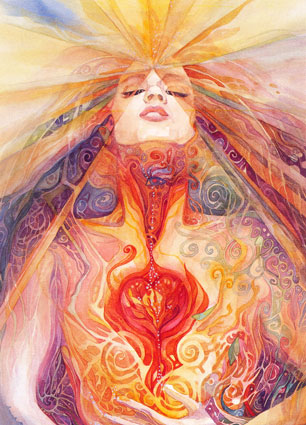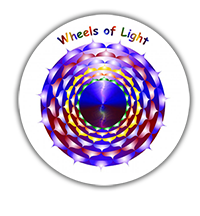Breast Cancer Prevention
Notes taken from my studies of Susun Weed, Christiane Northrup,
other herbal sources and my experiences.

Breast cancer is the cancer diagnosed most frequently in North American women. Research states that the risk factors that increase chances of developing breast cancer are said to be: family history, your menstrual and reproductive history, previous breast biopsies, lifestyle, and diet. Reference is made to African and Asian women as having the lowest breast cancer cases. However, what is missing are the emotional, mental and psychological contributions of this disease along with what we put into and onto our bodies. So how is Breast Cancer caused and what are the mind, body and spirit ramifications of this disease?
Let’s look at anti-perspirant deodorants. The word is an oxy moron. The anti-perspirants that “Never let you sweat” are only preventing you from a natural detoxification process, but it may be one of the contributing sources of breast cancer. Anti-perspirant prevents you from perspiring, thereby inhibiting the body from purging toxins from below the armpits. These toxins do not magically disappear. Instead, the body deposits them in the lymph nodes below the arms since it cannot sweat them out.
Let’s talk about the bras that we are wearing. According to David Williams, MD- “Wearing a bra at least 14 hours a day tends to increase the hormone prolactin, which decreases circulation in the breast tissue. Decreasing circulation can impede your body’s natural removal of carcinogenic fluids that become trapped in the breast’s sac-like glands (lymph nodes). These glands make up the largest mass of lymph nodes in the upper part of your body’s lymphatic system.”
In a study conducted on the Fiji Islands, the astonishing connection between bras and the development of breast cancer were observed. In 1997, medical anthropologist Sidney Singer compared the incidence of breast cancer in two groups of women in Fiji. Half of the women wore bras and the other half went without. The diet, environment and lifestyle of both groups were the same. Singer discovered that those who wore bras had the same rate of breast cancer as American women. Those who went bra-less experienced practically no breast cancer whatsoever.
Donna Eden, author of Energy Medicine talks about how the underwire in bras mess up your energy meridians (which mirror your circulatory system) and clog the lymph nodes under breasts. She suggests a few simple massage techniques after removing your bra. Try tapping and gently massaging the area from the armpit and then stroke downwards and then curve in around the bottom of breasts. If there is any tenderness then you need to be doing this every day. Also massage underneath the breast at the bra line. Notice any lumpiness here which is a good indication that the bra is adversely affecting you. Ditch the bra whenever you can. Consider sports bras that aren’t too tight.
Currently our environment is full of toxins. Some of these toxins come from plastics are called xenoestrogens. These xenoestrogens mimic estrogens in the body. As a result, most women have too much estrogen and not enough progesterone in their body. This can be identified by strong PMS and menopausal symptoms. Estrogens do not initiate cancer but some of them, especially estradiol, promote it. Where does estradiol come from? Some women take it in pills to relieve menopausal symptoms, but most of it is produced by our own ovaries during each menstrual cycle. The more menstrual cycles you have, the more estradiol you’ll produce and the greater your likelihood of breast cancer. Late onset of menses, early menopause, pregnancy, lactation and some birth control pills reduce the number of menstrual cycles and thus the risk of breast cancer.
Phytoestrogens: Foods for the Breasts
Another way to moderate your risk from exposure to estradiol is to consume phytoestrogens. Phytoestrogens are plant hormones found in foods and herbs such as lentils, dried beans, tofu, fermented soy products, burdock roots, parsnips, leafy greens, pomengranates, whole grains, edible seeds, sweet potatoes, pomegranates, red clover, hops, ginseng and wild yam. These foods may stop the breast cells from absorbing estradiol.
Estrogens are metabolized by one of two pathways: the short safer path or the longer cancer-promoting path. Phytoestrogens and other non-cancer promoting estrogens take the quicker shorter path. Estradiol, HRT and xenoestrogens must take the slower long path. When there are plenty of short path estrogens in the blood (phytoestrogens), carcinogenic estrogens arrive at the breast cells only to find themselves blocked from entry.
Another way to decrease your risk of breast cancer is to ingest good fats. Greek women who ate olive oil more than once a day lowered their risk of breast cancer by 25 percent. Use organic fats like local raw butter and goats milk cheese. Women on low-fat diets are found to have arthritis, PMS, hot flashes and infertility issues.
Nurturing Ourselves
Breasts are the physical metaphor for giving and receiving. Women give and give until the well runs dry. Women must learn to nurture themselves before others. Breast cancer is related to our need to be self-nurtured. The major emotion behind breast lumps and breast cancer is hurt, sorrow and grief. Preventative medicine is the key. Don’t wait to pay attention to your breasts. Love yourself now!
Few women examine their breasts monthly. In order to encourage self-love and a healthy heart, get to know your breasts. Understand their unique anatomy. Women need to learn that their breasts are a normal part of the body and that they deserve loving attention. They need gentle massage which helps prevent cancer as well as detect it. Breast massage helps keep breast skin supple and adds resiliency to breast tissue. By getting to know your breasts you understand their dips, curves and lumpiness. Then you can take action when you feel something is out of place. YOU are your best early warning system for cancer.
Breast Self-Exams
A good time to start regular breast self-exams would be after your menstrual cycle. When you touch your breasts do so with care and respect. Learn how your breast tissue feels. Lie on your back with one hand behind your head. This will make it easier for you to access all parts of the breast. Breast tissue extends up into the armpit (axilla), in what is called the tail of Spence. Lymph nodes that drain the breast tissue are also located in the armpits.
Make a ritual out of your monthly breast exam. Start a bath, light a candle, put on your favorite music and massage your whole body with loving care. Remember you must love yourself in order to authentically love others.
Try using nourishing herbal oils just for your breasts. Evening primrose oil capsules can be ingested (high in EFA’s) and work well to relieve painful breasts. Other herbs/allies to consider for oils would be: Burdock seed, Calendula blossom, Castor oil, Comfrey root, Dandelion root, Plantain leaf, Poke root, St John’s Wort, Yarrow and Yellow Dock and Red Clover blossoms. Massage in little circles with light pressure. Trace a spiral starting at your armpit around and around your breast, until you reach your nipple. Notice any stuck emotions that may arise during this experience and let them go. Make a homemade Breast Massage Oil infused with herbs just for the breast in a base of castor oil or pomegranate oil.
Defining Lumps in Breast Tissue
First off, most lumps are harmless. Don’t get caught up in your own fears. Sit and focus on your body for a few days before you make a rash decision to undergo a series of tests and feed into the fears of others. Your body is communicating to you, stop and listen a moment. If the lump increases or doesn’t dissipate, consider seeing a doctor. Be centered without fear during this phase.
Is it moving freely or is it fixed? Put your finger on your eyelid and move it around on your eyeball. It moves freely right? Now put your finger on the tip of your nose and try to move the skin. It is fixed. If lumps move freely, they are almost always benign (not cancer).
Fibroadenoma – Benign, round in shape, rubbery, firm texture, rarely painful, moves freely. More common in pre-menopausal women.
Cyst – Benign, round in shape, squishy to quite firm in texture, often painful, moves freely, can change size very quickly with changes in your menstrual cycle, diet or emotions. Common in pre-menopausal women, uncommon after menopause unless on Hormone Replacement Therapy (HRT). Cysts do not increase breast cancer risk. Some studies show that women with lumpy, fibrocystic breasts are slightly less likely than average to have breast cancer during their reproductive years.
Lipoma (fat necrosis) – Benign, irregularly shaped, soft or firm textured. Usually painless and fixed. Initiated by an injury to the breast.
Calcifications – Benign, but may be precursor to cancer. Tiny deposits of calcium some micro and only visible in x-rays. Abnormal, dead cells, including scar tissue and dead cancer cells, attract calcium. Calcifications that are large, few in number, widely dispersed and round imply benign causes. Calcifications that are small, numerous, clustered asymmetrically shaped, and found in only one breast imply cancer.
Cancerous mass – Malignant, irregular in shape, texture quite firm (like a grain of uncooked rice or a bit of wire). Lumps rarely cause pain, but they can. Fixed, they move only with the underlying tissue. May grow quickly or slowly but rarely shrinks on its own. Most common is postmenopausal women.
Mammogram Risks
Perhaps no aspect of breast cancer is more widely publicized than screening mammography. However, screening mammograms don’t prevent breast cancer. A mammogram is an x-ray and x-rays cause cancer. The ads promoting regular screening mammography are paid for by those who stand to profit from their widespread acceptance and use—the manufacturers of the equipment and x-ray film.
All mammograms are x-rays. A mammogram uses radioactive rays to “see” breast tissues. X-rays are known to cause DNA damage in breast cells. A diagnostic mammogram is used when a woman or her practitioner feels a lump and wants to see it. Most diagnostic mammograms are not one x-ray but a series of x-rays, usually two per breast.
There is now a high-tech cancer screening method called Breast Specific Gamma Imaging (BSGI). The technique uses a camera placed against a woman’s breast to take a picture of cancer cells that “light up” due to their increased blood supply and increased energy production. This is even worse than a mammogram.
In order for the cells to “light up” the woman must receive an injection of a “tiny” amount of RADIATION intravenously. It is usually used in conjunction with a mammogram compounding her radiation exposure. YUCK!
Instead consider Thermography which also recognizes and detects the increased blood supply of cancer cells as well as the rapid energy production by the heat that they release. No radiation is involved. No invasion into the body is necessary. It is 100% safe. No amount of radiation can be considered safe. “Tiny” amounts or low dose radiation exposure has been demonstrated to cause unrepairable double strand breaks of DNA in breast tissue.
Make no mistake, breast cancer and its surrounding tests and treatments is a huge money making industry. Look for a doctor that practices THERMOGRAPHY for breast cancer detection or get an ULTRASOUND. Corroborating evidence can be found at www.newdimensionthermography.com.
Having an anti-cancer lifestyle will decrease your risk of breast cancer in a way that regular mammograms won’t. Practice breast massage, phytoestrogenic foods, healthy exercise and nurture your emotional needs. Love your breasts. Their energy gives out so much, yet we forget to receive. Please read my article Our Healing Heart.
For further information on alternative healing therapies for cancer and to read the journey of Darlene Gant, go to www.canceravenues.com.
